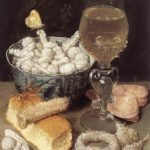I submitted some of my sugar paste research the other week to an “Unfinished Projects” display and got some great feedback. One of the more common questions was: what would 16th century sweetmeats look like? Most of what I do is about recreating a flavour rather than shape of an object so I thought I’d look into it. There are, of course some descriptions of what you can make in the cookery books but they are mostly suggestions of things you can counterfeit such as plates, dishes, cups, glasses and platters, but they also mention walnuts and small loaves of bread or buns.
I didn’t think that was enough to answer the question so I decided to look for some artwork depicting them (I’ll leave my discussion of ephemeral arts in the SCA for another time). Now I’m not an art historian by any stretch of the imagination so if you have better interpretations or know of art I haven’t mentioned please let me know.
The problem is that until the “still life” regained popularity in the late 16th century we don’t have a lot, and what we do have isn’t easy to analyze. For example, here’s a woodcut that apparently shows dessert in the mid 16th century:

It’s not a great quality shot of it, but the problem is that it doesn’t matter. The woodcut doesn’t show any of the food except in a general way. Instead it’s paintings from the very early 17th century that have been the most useful.
- Still Life with Candy, Georg Flegel
- Still Life with Bread and Confectionery, Georg Flegel
- Still Life, Georg Flegel
- Still Life with Fruit Carnations and a Mouse, Georg Flegel
- Still Life with Parrot 1, Georg Flegel
- Still Life with Parrot 2, Georg Flegel
- Still Life with Four dishes and Glasses of Wine 1, Osias Beert
- Still Life with Four dishes and Glasses of Wine 2, Osias Beert
- Three Dishes of Sweetmeats and Chestnuts with Three Glasses on a Table, Osias Beert
- Dutch banquet with cheese, bread, nuts and fruit, Floris Van Dyck
The artists represented here are Georg Flegel, in Frankfurt, Osias Beert, in Antwerp, and Floris Van Dyck, in Haarlem. None of them were in England, but they were all, at least, from a region and time where exchange with England would have been common, especially as they were mostly painted during the Twelve Years’ Truce.
The confections represented in the artwork breaks down to four categories
- Comfits (the most plentiful)
- ragged comfits that look like they’re made with spices (most common)
- smooth comfits made with almonds (smooth comfits take more time than ragged)
- comfits that look like and may in fact be dried fruit
- Biscuits of various shapes
- Pressed cookies or marzipan (generally in the shape of letters)
- Oval and circular discs with a similar visual texture to my sweetmeats
And just a note that the items I’m guessing are marzipan could just as easily be pressed sugar.
The discs are the items I want to focus on. They’re seen in both Still Life with Candy and Still Life with Parrot, both by Flegel. They seem to be about 1/4 inch thick, either round or oval, and appear in white, whitish brown (similar to one of my cinnamon attempts), and a light whitish yellow. These could be sweetmeats similar to what I’ve been making. If so then that gives me a shape to work with in the future. A circular or oval shape about an inch to an inch and a half across and about a 1/4 inch thick.
There was one more object to look at and that’s the two white plates in Still Life with Four Dishes and Glasses of Wine by Beert. Likely the plates are exactly what they seem, but based on the colouring of the dishes it’s not beyond the realm of possibility that they’re sugar plates.
From looking at the art clearly comfits are the more common sweets, but it was interesting to see items that may be the sweetmeats I’ve been making. It is, however, clear that if I want to be using whole spices, such as the balls I stuck with cloves, I should go the comfit method rather than the sugar paste.













1 Comment
Sugar Paste – Tomas de Courcy · November 7, 2016 at 8:37 am
[…] and platters, but they also mention walnuts and small loaves of bread or buns. To add to this I examined still life paintings from the early 17th century to identify possible sugar paste confections, or […]